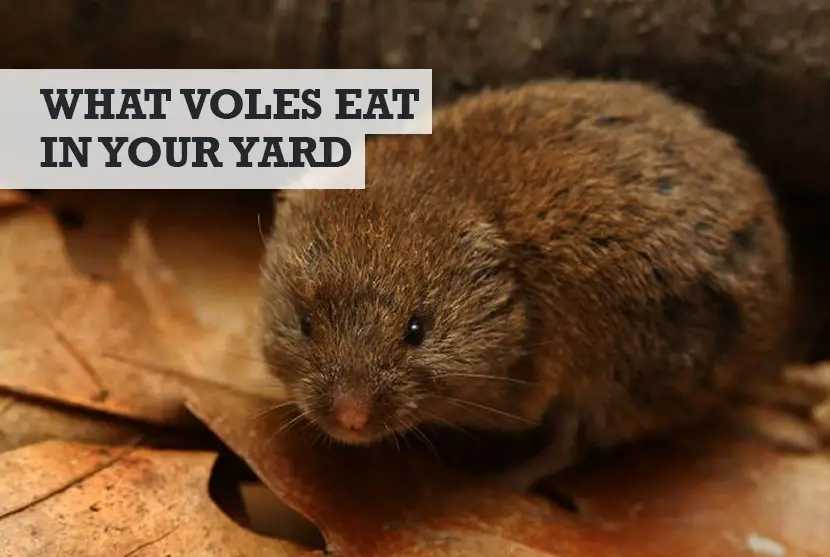This is the fourth in my series explaining how to deal with voles in your yard. You will find links to the other guides throughout this article, and at the bottom of the page. This one explains what voles like to eat in yards and gardens.
By understanding their food source, you can take steps to discourage or get rid of voles from a backyard or garden space. What attracts voles to your yard will be a plentiful food supply – plus hiding spots and a lack of predators (more on that lower down the page.
What do voles eat in your yard?
Voles eat plant material most of the time but are also opportunistic eaters meaning they will eat meat if they find dead animals to feed upon, as well as insects. This makes voles omnivores, rather than herbivores.
Given that voles eat vegetation in the main, it’s no surprise that they will find yards and gardens feasting zones. Here’s how their diet breaks down, and what you can do to eliminate or protect the food source if you want to discourage voles (more tips).
1. Bark
Voles will strip bark from trees to eat. Smaller voles will damage the tree bark close to the ground, whereas bank voles will go higher, stripping bark from half to two meters.
To prevent voles eating tree bark in your yard or garden, these protectors on Amazon are ideal for saplings and small trees.
2. Bulbs
Voles also like eat bulbs, and the frustrating thing is, you won’t know they are doing it until it’s too late. They will dig their holes underneath planters or in pots to get the bulb underneath.
By the time your plants have died, the voles have left (with full bellies).
3. Carrion
Whilst voles main exist on a vegetarian diet, if you have dead animals in your yard, voles will eat them. I know one guy who went on a mission to kill moles in his backyard. This ended up attracting voles and snakes, further amplifying his critter problem!
On a similar topic, voles will also turn cannibalistic if they have no other food sources. This is noted on the Alaska Department of Fish and Game website who say:
“Microtus voles eat mainly grasses and seeds, while the red-backed voles are omnivorous and will eat grass, seeds, fruit, lichens, fungi, insects, and meat. If a vole is caught in a trap, others will feed upon the trapped vole.”
4. Clover
Whilst wild clover is considered poisonous to people when eaten in large quantities, voles have no such qualms and will eat it.
If voles are eating clover in your yard, let’s hope they don’t munch one of the famous lucky four-leafed ones. If they do, you won’t be feeling lucky when you see the vole holes in your lawn.
5. Grass shoots
Voles can play havoc with lawns. It’s not just the holes they dig into the ground and the track marks they leave, but they will also eat grass shoots.
Some gardeners I know have used sonic repellents (view on Amazon). These stakes stick in the ground and emit sounds into the earth that burrowing critters hate, hopefully making them leave your yard a more accommodating environment.
6. Fruit
Voles will eat fruit in your yard. They cannot climb very well, so the fruit they eat will be ones that fall from trees or that are low to the ground.
If you grow strawberries, you will notice that voles with a taste for sweet flavors won’t waste any time in decimating your crop.
Make sure all fruit has netting over it, and look for evidence of holes in the ground (they do look similar to rat holes). Also clean up any fruit that falls to the ground each day to stop encouraging feeding.
7. Insects
Voles will also eat insects in your yard, so in this respect can be quite helpful to gardeners. This will be more typical in winter when cold weather means less vegetation for them to eat, grubs being another favorite.
It might sound controversial, but I don’t believe that voles are always bad for yards.
8. Leaves
Another thing that voles eat in your yard will be leaves. As already mentioned, they cannot climb so will eat leaves that have fallen to the ground.
To discourage this behavior, regularly sweep up leaves and plant debris. As well as eating leaves, voles will also initially take cover and warmth in leaf piles before digging their holes.
9. Moss
Field voles have also been reported eating moss (view source). Again, if you want to get rid of moss in your yard, a moss eating colony of voles could be just the thing you want.
10. Oats and corn
If you yard is near farmland, you could have voles in your yard who are eating corn and oats. The Royal Horticultural Society of Gardening say:
“Mice and voles can eat the recently sown seeds of peas, beans and sweet corn and kill seedling plants by grazing on the foliage.”
11. Pet food
Be very wary about feeding your pets outdoors or leaving their dirty pet food bowls in your yard. Voles will love to eat at any meaty scraps found in dog food bowls or similar.
Keep your yard clear and clean of debris, and it’s not going to be as appealing to voles.
12. Roots
Like bulbs mentioned earlier, roots of plants are also something that voles eat in yards. They will burrow underground eat the roots, which tends to have lots of moisture in.
13. Seeds
Voles also eat seeds which is a pain for those who encourage birds into their yard. Instead of putting seeds out on lawns, make sure the seed feeders are up high away from voles, who are poor at climbing.
14. Shrubs and herbaceous plants
And lastly, voles are not that fussy. If it’s green and plant-based, it’s fair game for them to eat in your yard.
As you can see from this list, voles have a mainly vegetarian diet, which isn’t that easy to eliminate food sources from in a backyard space!
Do voles eat at night?
Some voles do eat at night, so you won’t see them in your yard easily. Not all voles are nocturnal eaters though; field voles are active at night and day.
What do voles eat in the winter?
Voles don’t like cold so will dig deep in winter to keep warm. In winter they like to eat food that gives them long-lasting energy to cope with cold days. This includes eating things like bulbs, roots, and tubers.
What attracts voles to your yard?
As well as food sources in your yard, there are other things that will attract voles there in the first place. If they then find an abundance of food, they will stay.
By knowing what attracts voles to your lawn or garden, you can then take the steps needed to get rid of them.
Yards and gardens make the great habitats for voles, as they offer lots of places to hide, as well lots of varied food sources. Gardeners hate voles as they can very quickly eat through seed supplies, blubs, and cherished plants – and even strip bark from trees.
This can become a significant issue if there are no predators in your yard to feast on voles. The result can be a population explosion. This then means the voles are more likely to become a nuisance as they eat on more plant material in your yard.
Voles are also attracted to yards that have healthy and well-watered, damp lawns as well as warm compost piles you might have in corner of the garden.

They also like long grass. If you can regularly mow the lawn to no more than an inch, it will also help to keep voles away from the yard.
It’s also very likely that you have more voles in your yard than you think. They are very shy and are (mainly) nocturnal, so won’t be a critter you are likely to see during the day.
Voles are also higher in number in backyards during fall (autumn) months and can cause a lot of damage to lawns in winter by digging their hole and tunnel systems.
In conclusion, if you can reduce what voles like to eat in your yard, they won’t want to live there.
More backyard guides…
Image of yard vole used in the header is public domain and found on Wikipedia: https://en.wikipedia.org/wiki/Woodland_vole#/media/File:Woodland_Vole_Microtus_Pinetorum.jpg




